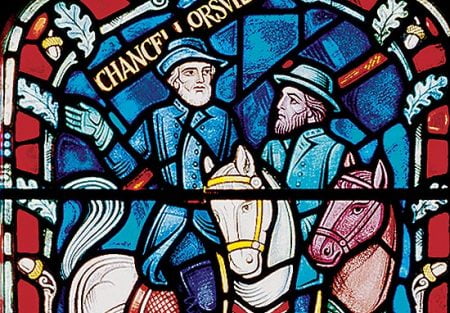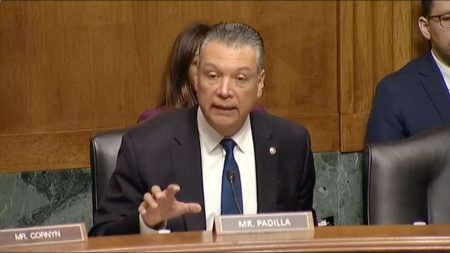Washington National Cathedral Replaces Stained Glass Windows Featuring Confederate Iconography

Kerry James Marshall, Elizabeth Alexander to create works that focus on racial-justice and equality.
The Washington National Cathedral will replace its former stained-glass windows featuring Confederate iconography, removed in 2017, with racial-justice themed windows created by world-renowned artist Kerry James Marshall, described by The New Yorker as “a virtuoso of landscape, portraiture, still-life, history painting, and other genres of the Western canon.”
The Cathedral’s commission represents Marshall’s first time working with stained-glass as a medium, and the windows are expected to be his first permanent public exhibition anywhere in the country.
In addition, celebrated poet, author, and scholar, Dr. Elizabeth Alexander has agreed to pen a new poem that will be inscribed in stone tablets alongside Marshall’s window installation, overlaying the previous stone tablets which venerated the lives of Confederate soldiers. Completion of both Marshall’s new windows and the stone tablets featuring Dr. Alexander’s new poem is expected in 2023, at which time they will be permanently installed at the Cathedral.
The Cathedral removed windows featuring Confederate Generals Robert E. Lee and Thomas “Stonewall” Jackson – which were located along the southern face of its nave, or its main worship space – in September 2017, following the white nationalist violence in Charlottesville, Virginia. In the summer of 2020, amid the historic movement for racial justice following the police killing of George Floyd, the Cathedral began collaborating with the Smithsonian’s National Museum of African American History and Culture (NMAAHC) to plan the public exhibition of the Robert E. Lee window.
Artist Kerry James Marshall joins Cathedral Dean Randy Hollerith to discuss exciting plans to reimagine stained glass windows that previously honored Confederate generals.

“For nearly 70 years, these windows and their Confederate imagery told an incomplete story; they celebrated two generals, but they did nothing to address the reality and painful legacy of America’s original sin of slavery and racism. They represented a false narrative of what America once was and left out the painful truth of our history,” said The Very Rev. Randolph Marshall Hollerith, dean of Washington National Cathedral. “We’re excited to share a new and more complete story, to tell the truth about our past and to lift up who we aspire to be as a nation.”
Hollerith continues, “We are thrilled that Kerry James Marshall has agreed to lend his immense talents and creative vision to this important project. He is one of the greatest artists of our time, and we are honored to add his artistic legacy to the iconography of this Cathedral. To complement Mr. Marshall’s work, we welcome the words of Dr. Elizabeth Alexander, one of America’s great poets and a native Washingtonian, whose incredible ability to capture the pain of yesterday and the promise of tomorrow will be felt in our house of prayer through her inscribed words.”
Marshall—the artist and professor whose paintings depicting Black life in America have been sold, viewed, and showcased across the world for decades—will design the stained glass windows that will replace the Lee/Jackson windows. His new windows will reflect the Cathedral’s stated desire for new windows that “capture both darkness and light, both the pain of yesterday and the promise of tomorrow, as well as the quiet and exemplary dignity of the African American struggle for justice and equality and the indelible and progressive impact it has had on American society.” Marshall has taught painting at the University of Illinois at Chicago and has been named to TIME’s annual list of the 100 most influential people in the world.
“This project is not just a job – I don’t need the work – or only a piece of art. It’s kind of a calling, and a real honor to be asked,” said artist Kerry James Marshall. “The themes that the Cathedral committee articulated set a great challenge for me as an artist and as a Black American man. The goal is to make truly meaningful additions to an already rich and magnificent institution, to make the changes they have embraced truly worth the effort.”
As a decorated poet, educator, memoirist, scholar, cultural advocate, Washington DC native, and president of The Andrew W. Mellon Foundation, Dr. Alexander dedicated decades of her life and work to the pursuit of creating and telling more truthful representations of our collective history – a theme she will explore in her commissioned poem for the Cathedral. She has held distinguished professorships at Smith College, Columbia University, and Yale University, where she taught for 15 years and chaired the African American Studies Department. In 2009 Dr. Alexander composed and delivered “Praise Song for the Day” for the inauguration of President Barack Obama, and is author or co-author of fourteen books, including Pulitzer finalists American Sublime, and The Light of the World.
“I grew up in Washington, D.C., and spent time throughout my childhood in the hallowed cathedral. I am incredibly honored to be a part of the National Cathedral’s effort to ensure that those who worship within its sanctuary know that it is truly a space for all people, and that the stories relayed through its sacred walls, windows and other iconography represent the truth of our nation,” said Dr. Elizabeth Alexander. “I’m delighted to work in close collaboration with my dear friend of over thirty years Kerry James Marshall on this inspiring project for the Cathedral as we consecrate its sacred space with our artistic work.”
As artists adept at capturing the lived experience of Black Americans Marshall and Alexander will add a new and important chapter to the Cathedral’s history of art and architecture, and reflect the Cathedral’s aspirations to be a sacred gathering place where all Americans can see themselves reflected in its expanding art and iconography.
The Lee/Jackson windows were originally donated to the Cathedral by the United Daughters of the Confederacy and installed in 1953. The initial call for their removal came from then-Cathedral Dean Gary Hall in 2015, following the shooting at Emanuel African Methodist Episcopal Church in Charleston, SC. In 2016, the Cathedral formed a task force to study options for the windows’ future, which ultimately produced a report recommending further action. In 2017, after Charlottesville, the windows were deconsecrated and removed, and the space has been filled by a temporary placeholder since then. Once completed, the new racial justice windows will be installed, and they will remain a permanent part of the Cathedral’s world-renowned sacred iconography.
For everything there is a season, and a time for every matter under heaven: a time to be born, and a time to die; a time to plant, and a time to pluck up what is planted; a time to kill, and a time to heal; a time to break down, and a time to build up; a time to weep, and a time to laugh; a time to mourn, and a time to dance; a time to throw away stones, and a time to gather stones together; a time to embrace, and a time to refrain from embracing ; a time to seek, and a time to lose; a time to keep, and a time to throw away; a time to tear, and a time to sew; a time to keep silence, and a time to speak; a time to love, and a time to hate; a time for war, and a time for peace. ~ Ecclesisates 3:1-8






